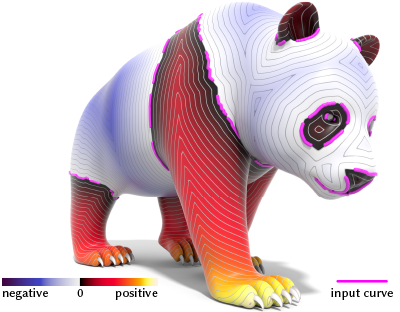A Heat Method for Generalized Signed Distance
| Nicole Feng | Keenan Crane |
ACM Trans. Graph. (2024)

We introduce a method for approximating the signed distance function (SDF) of geometry corrupted by holes, noise, or self-intersections. The method implicitly defines a completed version of the shape, rather than explicitly repairing the given input. Our starting point is a modified version of the heat method for geodesic distance, which diffuses normal vectors rather than a scalar distribution. This formulation provides robustness akin to generalized winding numbers (GWN), but provides distance function rather than just an inside/outside classification. Our formulation also offers several features not common to classic distance algorithms, such as the ability to simultaneously fit multiple level sets, a notion of distance for geometry that does not topologically bound any region, and the ability to mix and match signed and unsigned distance. The method can be applied in any dimension and to any spatial discretization, including triangle meshes, tet meshes, point clouds, polygonal meshes, voxelized surfaces, and regular grids. We evaluate the method on several challenging examples, implementing normal offsets and other morphological operations directly on imperfect curve and surface data. In many cases we also obtain an inside/outside classification dramatically more robust than the one obtained provided by GWN.
Nicole Feng, Keenan Crane (2024). A Heat Method for Generalized Signed Distance. ACM Trans. Graph., 43(4).
@article{Feng:2024:SHM,
author = {Nicole Feng and Keenan Crane},
year = {2024},
title = {A Heat Method for Generalized Signed Distance},
journal = {ACM Trans. Graph.},
volume = {43},
number = {4},
articleno = {92},
month = {jul},
numpages = {16},
url = {https://doi.org/10.1145/3658220},
doi = {10.1145/3658220},
publisher = {Association for Computing Machinery},
address = {New York, NY, USA},
}

